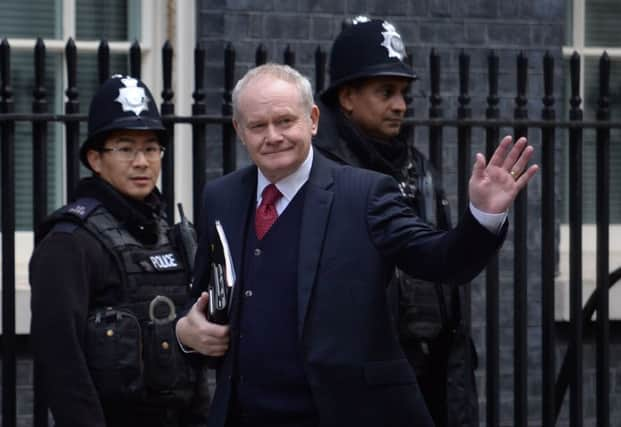Jim McAuley: McGuinness left mark on history in war and peace


Having left school at 15 and faced with the sectarian employment patterns of the day, he found himself denied a skilled job and went to work as a butcher’s assistant.
He was quickly, however, thrust into the cockpit of sectarian hatred that was Ulster in 1969 and, like many young men of his generation, found expression for his politics through the emerging Republican movement.
Advertisement
Hide AdAdvertisement
Hide AdHe never denied being an active member of the Provisional IRA, where he quickly rose through the ranks of volunteers to a position of leadership. In 1973 he was convicted after being caught in a car containing explosives and nearly 5,000 rounds of ammunition. He claimed to have left the organisation soon after, an assertion treated with much scorn by his opponents who saw his mark well into the 1990s, where it was said that he had involvement in some of the worst atrocies of the period. The security forces had little doubt that he was a key figure as the IRA reorganised and rearmed.
But this was not the only side to Martin McGuinness. Behind the scenes, he was engaged in secret talks with British personnel, which put in place the groundwork for the IRA ceasefire in 1994. His reputation as a hard man gave him the authority among Irish republicans to deliver later compromises, including disarmament and acceptance of a reformed RUC in the shape of the Police Service of Northern Ireland.
He became Sinn Féin chief negotiator in the run up to the Good Friday Agreement in 1998. Eventually, after a long and bumpy road, he became Northern Ireland’s deputy first minister, striking up an unlikely friendship with the most outspoken of opponents of the republican movement – Ian Paisley. Indeed their working relationship became so close that they became known as ‘the Chuckle Brothers’ for the wittiness and humour they displayed. Even after Ian Paisley’s death, his sons spoke warmly of him and there was continued close contact with his family.
Personal relations cooled with later unionist leaders, he had a mainly working relationship with Peter Robinson and almost none at all with Arlene Foster.
Advertisement
Hide AdAdvertisement
Hide AdBut McGuinness seemed determined to play his part in bringing the two communities together and at times risked both his personal security and reputation to do so.
He condemned Irish dissident republicans as traitors to Ireland and berated them for trying to disrupt the peace process. He left them in little doubt that violence was no longer a legitimate objective, declaring that his war is over. He visited the Somme war graves and met and shook hands in public with the Queen. While declaring his allegiance to the Republic of Ireland football team, he even attended Northern Ireland games.
In a society as divided socially as Northern Ireland. the symbolism of such deeds was huge. Later he decried the DUP leader for not being willing to undertake reciprocal gestures.
Notwithstanding his past, he seemingly changed and brought peace to the streets of Northern Ireland where he had previously brought murder, mayhem and destruction. There are those who question such gestures and those who say ‘once a gunman’.
Advertisement
Hide AdAdvertisement
Hide AdCertainly, the voices of victims and survivors of IRA violence will sound loudly and rightly alongside those praising the man, and demand that he and others be held accountable for the many atrocities during the years of IRA violence. His death comes at a perilous time for Northern Ireland, currently without a government, with a rising sectarian temperature, demonstrated by the recent election and growing fears over the implications of a hard Brexit and the possible effects of a new border control in Ireland.
There were two clear parts to the life of Martin McGuinness – the first as a street fighting member of the IRA, the second as a leading politician who was prepared to work within the confines of the Assembly and deny the validity of violence. Whether the two parts are distinct, or as some see them as part of a Sinn Féin plan to bring about the downfall of Northern Ireland depends, of course, on political perspective.
Martin McGuinness was a complex and complicated character. The IRA leader was reviled by some, glorified by others, but in later life he made huge efforts on behalf of the people of Northern Ireland, and to win over many who had regarded him only as being a street fighter.
Professor Jim McAuley is an expert in the politics of Northern Ireland at the University of Huddersfield.